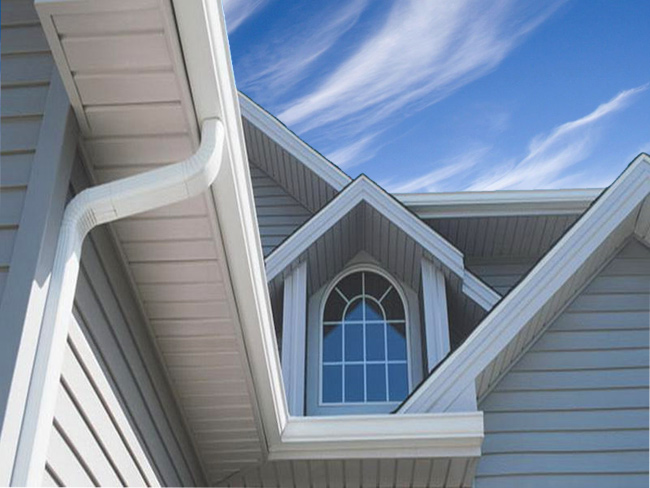As hurricane season approaches, homeowners in coastal and storm-prone areas must begin preparing their properties to endure the harsh winds, rains, and debris that come with these powerful storms. One of the most critical yet often overlooked aspects of roof maintenance is protecting the fascia boards. These boards play an essential role in your home’s roofing system, and if left unprotected, they can lead to costly damage, especially during hurricane season.
In this article, we’ll explain the importance of fascia boards, how they contribute to the overall integrity of your roof, and provide you with valuable tips on how to protect them before the storm season arrives.
What Are Fascia Boards and Why Are They Important?
Fascia boards are the horizontal boards that run along the edge of your roofline. They are typically made of wood, composite material, or PVC and serve several purposes, including supporting the roof’s gutter system and protecting the underlying roof structure from the elements. Fascia boards are essential in ensuring the proper drainage of rainwater, as they provide a secure base for gutters and prevent water from leaking into the roof cavity.
Without properly maintained fascia boards, you may notice water damage, mold, or even structural issues over time, especially if the fascia becomes rotted or detached due to weather exposure. In addition to their protective role, fascia boards also contribute to the overall curb appeal of your home, offering a clean, finished look to the roofline.
Why Fascia Boards Need Extra Attention Before Hurricane Season
During hurricane season, the stakes are high. High winds and torrential rains can place significant stress on your home’s exterior, and the fascia boards are not immune to this force. The fascia’s position at the edge of the roof makes it particularly vulnerable to wind and water damage. If the fascia boards are already compromised due to wear and tear, they can fail during a storm, leading to roof leaks, gutter detachment, or worse, structural damage.
Strong winds from hurricanes can rip away fascia boards if they’re not properly secured, leading to potential water intrusion and damage to your home’s interior. Additionally, debris like tree branches, leaves, or flying objects during a storm can impact the fascia, causing cracks, splits, or even complete detachment.
To prevent these types of issues, it’s essential to ensure your fascia boards are in top condition before hurricane season strikes. Below, we’ll walk you through some critical steps to protect your fascia boards and safeguard your home from storm damage.
Step 1: Inspect Your Fascia Boards for Damage
The first step in protecting your fascia boards is to thoroughly inspect them for any signs of damage. Look for issues such as:
- Rot or Decay: Wooden fascia boards are particularly susceptible to rot when exposed to moisture over time. If you notice soft spots or discolored areas, the wood may be rotting and in need of replacement.
- Loose or Detached Boards: Fascia boards that are loose or have begun to detach from the roof structure can be more easily ripped away during high winds. Check to ensure that the boards are securely fastened and free of gaps.
- Cracks or Splits: Any cracks or splits in your fascia boards can weaken their ability to withstand the force of strong winds. Even small cracks can eventually lead to bigger problems, so it’s essential to address these issues before they get worse.
- Pest Infestation: Fascia boards can sometimes attract pests like termites or carpenter ants, which can cause significant damage to the material. If you notice signs of pest infestation, consider consulting a pest control professional before the storm season begins.
By addressing these issues early, you can prevent further damage and ensure your fascia boards remain intact during a storm.
Step 2: Repair or Replace Damaged Fascia Boards
If you find any damage during your inspection, it’s crucial to repair or replace the affected fascia boards. For minor issues like cracks or loose nails, you may be able to make simple repairs using a hammer, nails, wood glue, or wood filler.
However, for more severe damage such as significant rot or structural weakening, it’s best to replace the fascia boards entirely. A professional roofing contractor can assist you with this process to ensure that the new boards are installed correctly and securely.
When replacing fascia boards, consider using materials that are more durable and resistant to moisture, such as PVC or composite materials. These materials are less prone to rot and decay, providing better long-term protection against the elements.
Step 3: Reinforce Fascia Boards for Storm Resistance
In addition to repairing or replacing damaged fascia boards, it’s also a good idea to reinforce them to provide extra protection during hurricane season. There are several ways to strengthen fascia boards, including:
- Using Hurricane Clips or Straps: These metal brackets are designed to secure the fascia boards to the roof framing, ensuring that they remain in place even in high winds. Installing hurricane clips or straps can provide additional protection against storm damage.
- Applying Waterproof Sealant: If your fascia boards are made of wood, applying a high-quality waterproof sealant can help prevent moisture from penetrating the material. This can reduce the risk of rot and decay, especially during the heavy rains that often accompany hurricanes.
- Upgrading Gutters and Downspouts: Since fascia boards support your home’s gutters, it’s a good idea to ensure your gutter system is in good condition before hurricane season. Clean gutters can help water flow freely, reducing the risk of water pooling around the fascia and causing damage.
Step 4: Clean and Maintain Your Fascia Boards
Regular maintenance is key to ensuring the longevity of your fascia boards. Before the storm season, clean the fascia boards to remove dirt, leaves, and debris. These materials can trap moisture against the fascia, promoting rot and decay over time. You can clean the fascia using a hose or a pressure washer, but be careful not to damage the boards by using too much pressure.
While cleaning, check for any signs of damage that may have occurred during the year. Regular cleaning and maintenance help prevent minor issues from escalating into major problems when the storm season arrives.
Step 5: Trim Overhanging Branches
One of the biggest threats to your fascia boards during a hurricane is flying debris. Overhanging tree branches or shrubs can break off during high winds, causing significant damage to the fascia and roof. To prevent this, trim any branches that hang too close to your roofline before hurricane season.
This simple step can go a long way in reducing the risk of fascia board damage during a storm.
Conclusion
Protecting your fascia boards before hurricane season is an essential part of preparing your home for the unpredictable weather that can come with strong storms. Fascia boards play a vital role in your roofing system, supporting gutters, enhancing drainage, and protecting your home’s structure from water damage.
By inspecting your fascia boards, making necessary repairs, reinforcing them with hurricane-resistant materials, cleaning them regularly, and trimming any overhanging branches, you can ensure that your fascia boards remain strong and intact throughout the storm season. This will help protect your home from water damage, prevent costly repairs, and give you peace of mind when a hurricane is on the horizon.
At Alpha 1 Roofing, we specialize in roof repairs and maintenance, including fascia board inspections and installations. Contact us today to ensure your roof is ready to withstand whatever this hurricane season brings. Your home deserves the best protection—don’t wait until it’s too late


